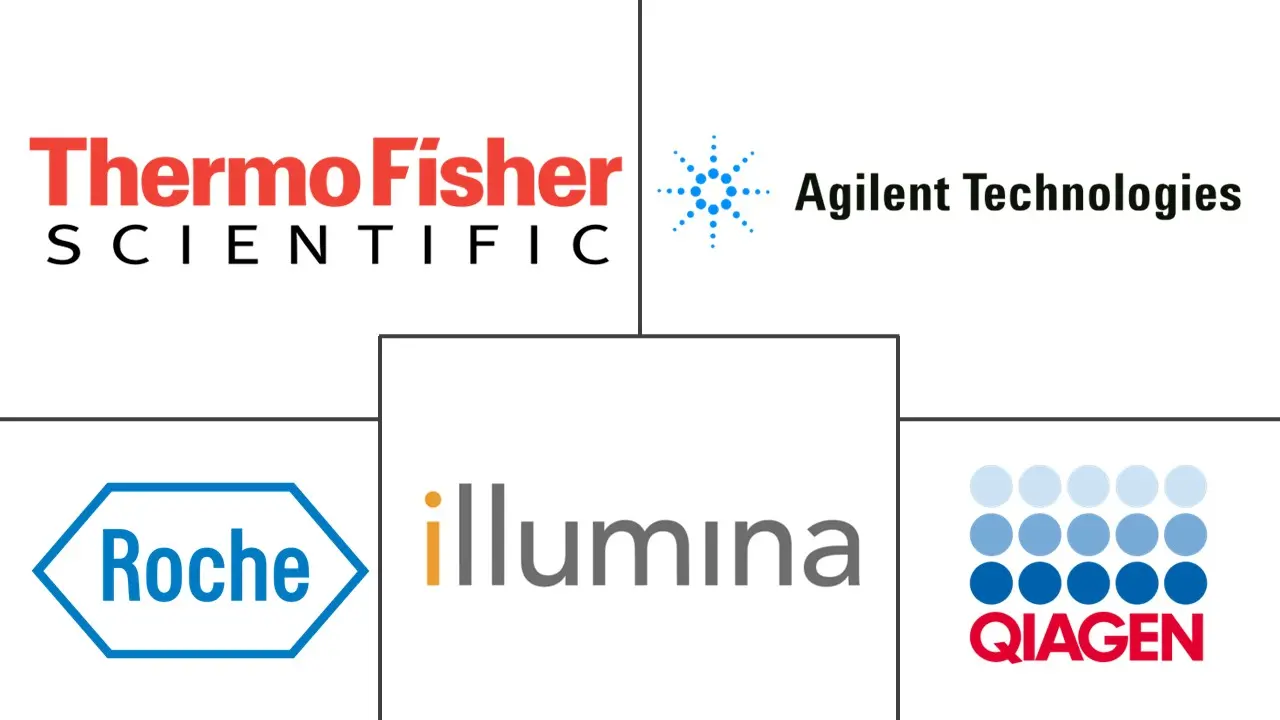Life Science Tools Market Size and Share
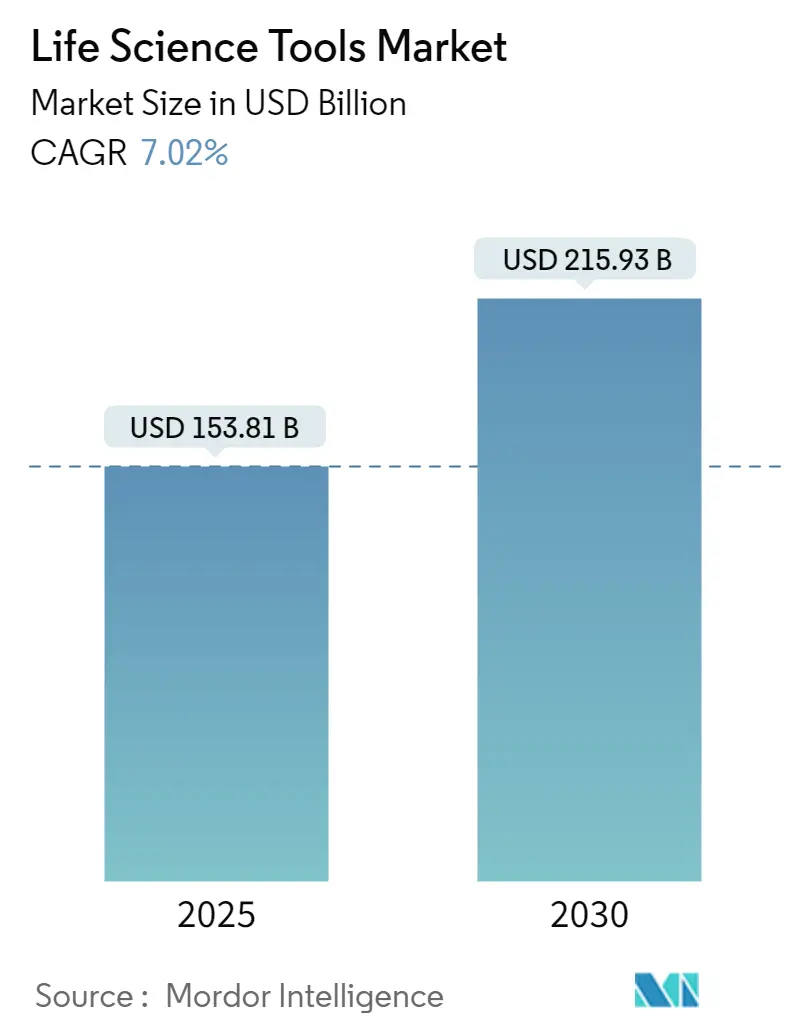
Life Science Tools Market Analysis by Mordor Intelligence
The life science tools market is valued at USD 153.81 billion in 2025 and is forecast to reach USD 215.93 billion by 2030, advancing at a 7.02% CAGR. Sustained uptake of precision-medicine assays, next-generation sequencing (NGS) platforms, and AI-enabled laboratory automation keeps capital equipment and consumables spending firmly on a growth path. Rising public-sector outlays—such as the United States Congress’ proposed USD 88 billion biotechnology package for 2025—coupled with stricter FDA oversight of lab-developed tests (LDTs) are reshaping compliance needs and driving fresh demand for validated instruments. North America continues to anchor the life science tools market with a 40.6% share in 2024, while Asia-Pacific leads growth at an 11.1% CAGR thanks to large-scale infrastructure investment in China, India, South Korea, and Singapore. Competitive momentum remains strong; established suppliers deploy mergers, acquisitions, and portfolio extensions to defend share and open new channels, yet lingering supply-chain fragilities and shortages of trained bioinformaticians temper the near-term outlook.
Key Report Takeaways
- By type, Services recorded the fastest expansion at an 11.8% CAGR, while Instruments retained 44.1% of the life science tools market share in 2024.
- By technology, Next-Generation Sequencing expanded at 17.4% CAGR; PCR & qPCR led with 23.0% share of the life science tools market size in 2024.
- By application, Proteomics Technology advanced at 13.5% CAGR, whereas Genomic Technology dominated with 33.8% of the life science tools market size in 2024.
- By end user, Diagnostic Laboratories grew the quickest at 12.2% CAGR; Research Laboratories held 58.5% of the life science tools market share in 2024.
- Geographically, Asia-Pacific posted the highest regional CAGR at 11.1%, while North America continued as the largest regional contributor with 40.6% share.
Global Life Science Tools Market Trends and Insights
Drivers Impact Analysis
| Driver | (~) % Impact on CAGR Forecast | Geographic Relevance | Impact Timeline |
|---|---|---|---|
| Rise in demand for biopharmaceuticals & growing research funding | +1.80% | Global; strongest in North America & Europe | Medium term (2-4 years) |
| Rising incidence of infectious diseases & genetic disorders | +1.50% | Global; higher impact in APAC & Africa | Short term (≤2 years) |
| Increasing adoption of NGS & single-cell analysis platforms | +1.20% | North America & Europe core; expanding to APAC | Medium term (2-4 years) |
| Expansion of CRISPR-based core-facility workflows | +0.90% | North America & Europe; emerging in APAC | Long term (≥4 years) |
| AI-driven high-throughput automation for multi-omics prep | +0.80% | Global; led by North America | Medium term (2-4 years) |
| Emergence of decentralized bioprocess labs in LMICs | +0.60% | APAC, MEA, Latin America | Long term (≥4 years) |
| Source: Mordor Intelligence | |||
Rise in Demand for Biopharmaceuticals & Growing Research Funding
Escalating focus on large-molecule therapeutics pushes laboratories to secure advanced mass spectrometers for protein characterization and high-parameter flow cytometers for cell therapy research. The U.S. ARPA-H budget of USD 2.5 billion earmarked for breakthrough health platforms underscores the government's commitment to cutting-edge instrumentation.[1]ARPA-H, “Fiscal Year 2025 Budget Overview,” arpa-h.gov European venture funding similarly rose, fueling orders for contract research organizations that now handle specialized analytics once kept in-house. Together, these forces accelerate capital buys and recurring consumables spend, reinforcing the life science tools market growth outlook.
Rising Incidence of Infectious Diseases & Genetic Disorders
WHO surveillance flagged heightened monkeypox and avian influenza activity in 2024, compelling public-health labs to broaden PCR testing capacity and stock multiplex NGS panels.[2]World Health Organization, “Disease Outbreak News—Monkeypox and H5N1 Updates,” who.int In parallel, nationwide rare-disease screening in the United Kingdom expanded genomic testing access by 25%, boosting demand for automated sample-prep systems. The dual burden of infectious threats and hereditary conditions strengthens the case for scalable, rapid-turnaround platforms, advancing the life science tools market in clinical and research environments alike.
Increasing Adoption of NGS & Single-Cell Analysis Platforms
With NovaSeq X and similar systems pushing whole-genome costs below USD 200, institutions can now pursue population-scale projects without compromising budgets. Single-cell innovations from 10x Genomics propelled instrument placements 40% higher in 2024, expanding applications in oncology and immunology. These shifts prompt facilities to reconfigure workflows around high-throughput, data-intensive approaches, spurring purchases of automated library builders and high-performance computing clusters.
Expansion of CRISPR-Based Core-Facility Workflows
Universities and research institutes have institutionalized CRISPR services, running hundreds of edits monthly with robotic liquid handlers and GMP-grade bioreactors.[3]Broad Institute, “CRISPR Screening Core Facility Services,” broadinstitute.org Standardized protocols shorten project turnaround and escalate consumable pull-through, while therapeutic CRISPR pushes demand for purification columns and advanced analytics in regulated environments, bolstering long-term equipment sales.
Restraints Impact Analysis
| Restraint | (~) % Impact on CAGR Forecast | Geographic Relevance | Impact Timeline |
|---|---|---|---|
| High capital cost of advanced instruments | -0.40% | Global; smallest institutions hardest hit | Short term (≤2 years) |
| Stringent regulatory requirements for LDTs | -0.30% | North America & Europe; spreading worldwide | Medium term (2-4 years) |
| Shortage of skilled bioinformaticians | -0.20% | Global; most acute in APAC & emerging regions | Medium term (2-4 years) |
| Reagent supply-chain risks from export controls | -0.15% | Global; impact highest where China is primary supplier | Short term (≤2 years) |
| Source: Mordor Intelligence | |||
High Capital Cost of Advanced Instruments
Flagship mass spectrometry platforms surpass USD 1 million, placing acquisition out of reach for smaller laboratories. Academic budgets struggle to reconcile instrument upgrades with staffing needs, leading many to rely on fee-for-service core facilities. Such budget pressures slow adoption and dilute the near-term life science tools market expansion trajectory.
Stringent Regulatory Requirements for Lab-Developed Tests
The FDA’s 2024 LDT rule mandates extensive validation and documentation, lengthening assay launch timelines and increasing compliance expenses. Smaller diagnostic labs often retreat from innovative offerings or partner with larger networks, curbing immediate instrument purchases and dampening growth.
Segment Analysis
By Type: Services Accelerate Outsourcing Trends
Services rose fastest at 11.8% CAGR as drug developers externalized analytics to control fixed costs and tap specialized expertise. Contract research organizations, now equipped with premium genomics and proteomics platforms, offer turnkey workflows that once demanded heavy in-house investment. Pharmaceutical clients value rapid capacity scaling and global site reach, propelling recurring fee income and enlarging the life science tools market.
Instruments maintained the largest 44.1% stake of the life science tools market share in 2024. Capital expenditure patterns remained resilient among top-tier pharma firms and research universities, while consumables supplied roughly 60% of recurring revenue for leading vendors. Hybrid models—leasing hardware bundled with services are taking hold, converting lump-sum equipment purchases into predictable operating outlays, and deepening customer lock-in.
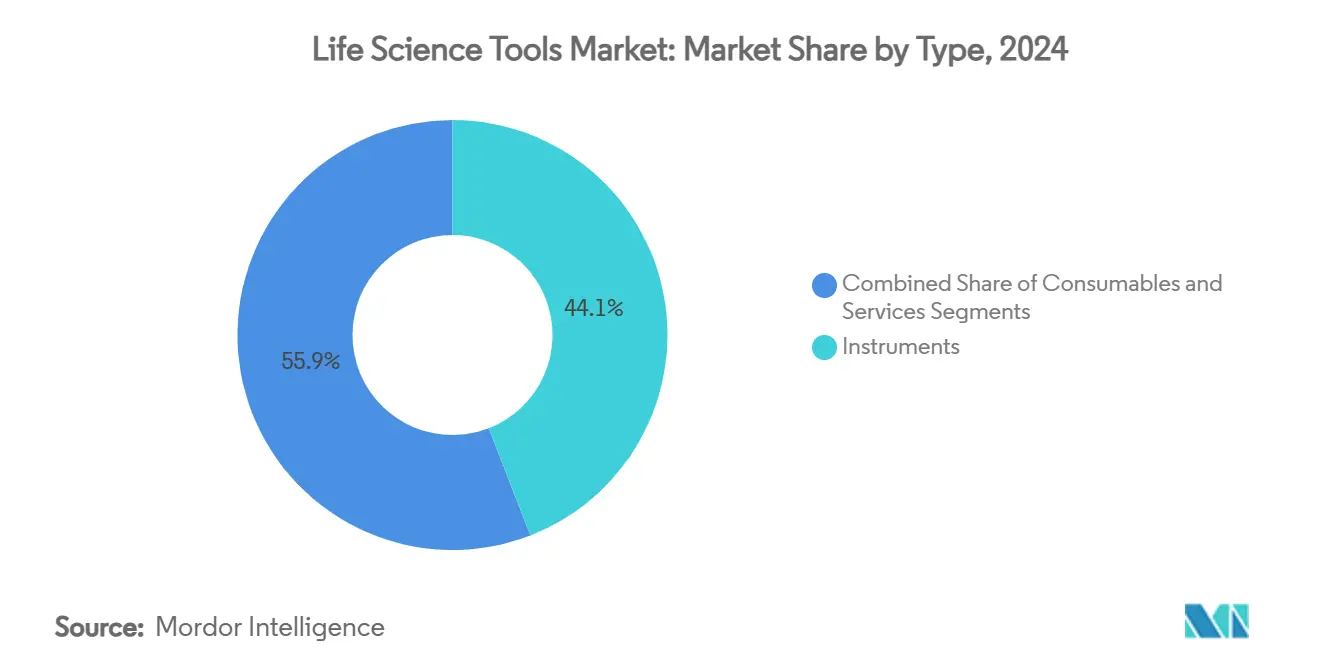
Note: Segment shares of all individual segments available upon report purchase
By Technology: NGS Disrupts Traditional Sequencing
Next-Generation Sequencing led technology expansion at 17.4% CAGR. Clinical labs increasingly swap single-gene PCR assays for multi-gene NGS panels that consolidate testing and uncover actionable variants. Population-scale genomics programmes from the United States to Singapore intensify instrument refresh cycles and spur computational infrastructure upgrades, sustaining the life science tools market.
PCR & qPCR, despite ceded growth momentum, still delivered 23.0% of the life science tools market size in 2024. Its entrenched role in rapid pathogen detection and gene-expression analysis preserves a steady consumables flow. Complementary technologies such as flow cytometry, mass spectrometry, and advanced separation systems broaden user options, ensuring diversified revenue pillars for suppliers.
By Application: Proteomics Gains Momentum
Proteomics posted the strongest 13.5% CAGR as drug discovery pivots toward functional protein readouts. Modern mass spectrometers, paired with refined sample-prep chemistries, now quantify thousands of proteins per run, fueling biomarker hunts and target-validation studies. The life science tools market benefits from elevated reagent usage and demand for high-resolution instruments optimized for intact protein and peptide analysis.
Genomic Technology retained 33.8% of the life science tools market size in 2024. Clinical sequencing for rare diseases, oncology, and pharmacogenomics remains a consistent revenue generator. Cell biology solutions, including high-content imaging and stem-cell culture systems, complement genomic and proteomic insights, encouraging labs to build multi-omics suites that consolidate workflows and extend spending.
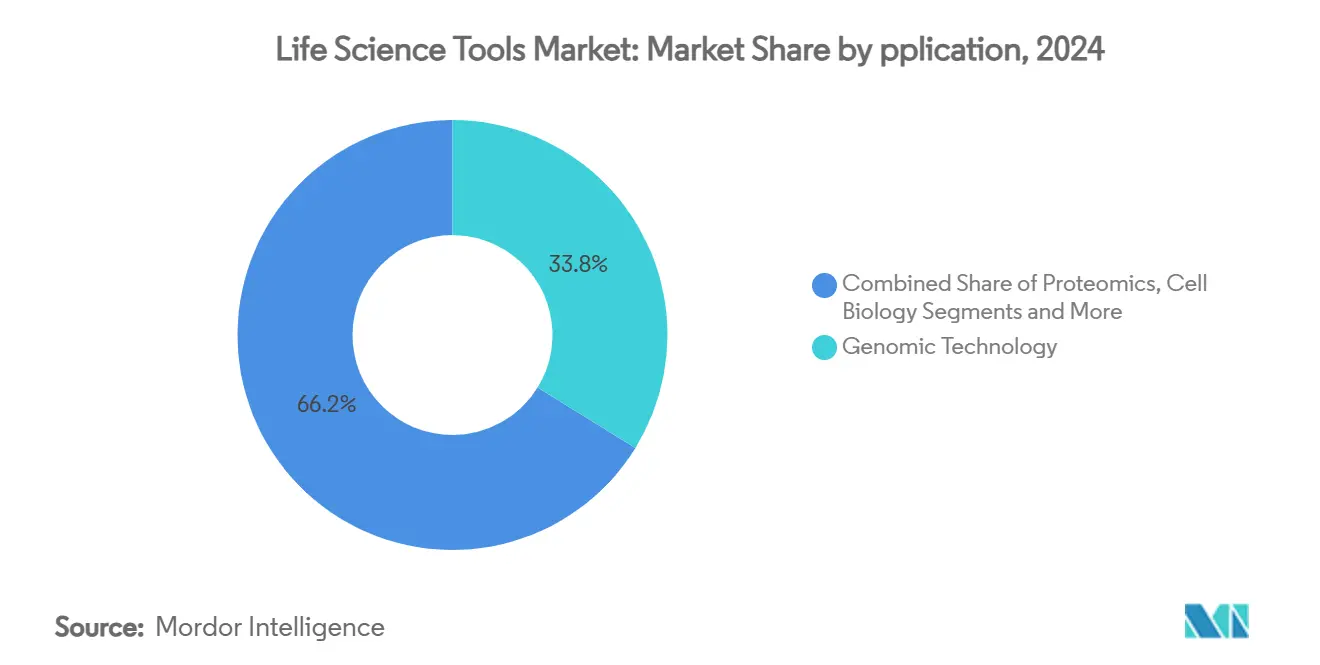
Note: Segment shares of all individual segments available upon report purchase
By End User: Diagnostic Labs Drive Clinical Adoption
Diagnostic laboratories expanded at a 12.2% CAGR as precision-medicine protocols entered routine practice. Laboratories upgraded clinical-grade NGS rigs and installed AI-assisted interpretation software that shortens report turnaround. Reimbursement frameworks covering genomic and proteomic tests accelerate instrument payback, energizing the life science tools market in healthcare settings.
Research laboratories held a 58.5% share in 2024, underpinned by sustained public-sector grants and pharmaceutical R&D outlays. Core-facility consortia allow smaller departments to access premium equipment, spreading utilization and amortizing cost across investigators. Industry-academia partnerships funnel additional capital into shared instrumentation, anchoring long-term demand.
Geography Analysis
North America accounted for 40.6% of the life science tools market in 2024, buoyed by National Institutes of Health funding and a cluster of global tool makers headquartered in the United States. Robust venture capital flows into Boston and San Francisco biotech corridors reinforce equipment refresh cycles, though ageing campus infrastructure and intensifying grant competition may nudge growth toward mid-single digits.
Asia-Pacific, advancing at an 11.1% CAGR, is the fastest-growing region. China directed more than USD 15 billion to biotech programmes in 2024, while India’s USD 2.4 billion infusion supported distributed vaccine and biologics sites. South Korea and Singapore continue building world-class sequencing and cell-therapy hubs. These initiatives anchor long-run investments in high-capacity NGS, mass spectrometry, and automated bioprocessing, adding heft to the global life science tools market.
Europe posts stable, mid-single-digit gains as macroeconomic uncertainties and energy costs weighed on new capital projects. Post-Brexit, the United Kingdom sought U.S. partnerships to maintain research momentum, while France and Switzerland remained strongholds for biologics analytics. Emerging centers in Poland and the Czech Republic adopted modular lab formats, providing fresh demand for compact instruments and entry-level consumables.
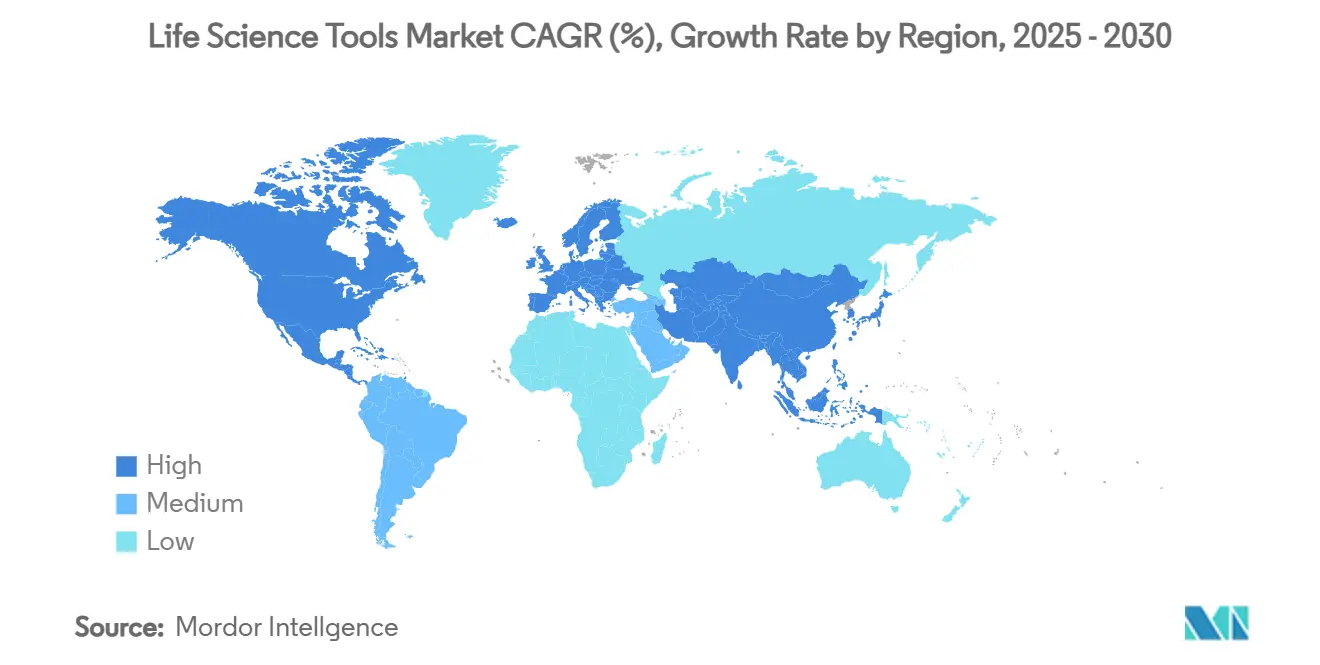
Competitive Landscape
Vendor concentration is moderate. Thermo Fisher Scientific, Danaher Corporation, and Agilent Technologies collectively hold sizable yet not dominant revenue positions, leveraging scale to invest in R&D and global distribution. Thermo Fisher’s USD 4.1 billion purchase of Solventum’s purification and filtration business in February 2025 broadened its bioprocessing suite and augmented cross-selling potential. Danaher folded Genedata’s bioinformatics stack into its portfolio in 2024, signalling a shift toward integrated hardware-software propositions.
Challengers such as Oxford Nanopore Technologies and Pacific Biosciences pursue differentiated sequencing chemistries that attract niche oncology and infectious-disease applications. AI-centric start-ups target data-analysis gaps by partnering with hardware vendors, aiming to bundle interpretation engines with instruments. Suppliers eye whitespace in decentralized manufacturing, field-deployable diagnostics, and full-workflow automation, areas where incumbents have limited penetration.
Strategic plays span technology licensing, region-specific manufacturing, and co-development alliances with pharma. For instance, Thermo Fisher partnered with the National Cancer Institute on the myeloMATCH trial, embedding sequencing tools in a high-profile precision-oncology study. Waters, Bruker, and BD launched application-specific columns, imaging profilers, and automated prep stations, respectively, sharpening competitive differentiation while expanding addressable spend.
Life Science Tools Industry Leaders
-
Agilent Technologies
-
Illumina, Inc
-
Thermo Fisher Scientific Inc.
-
F. Hoffmann-La Roche Ltd.
-
QIAGEN
- *Disclaimer: Major Players sorted in no particular order
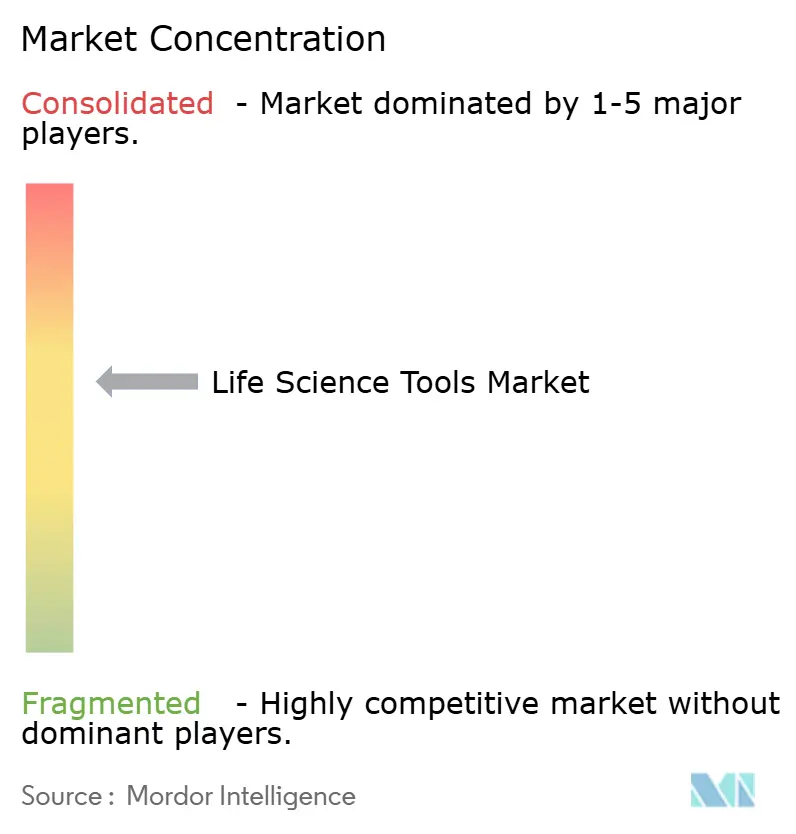
Recent Industry Developments
- February 2025: Thermo Fisher Scientific acquired Solventum’s Purification and Filtration Business for USD 4.1 billion, adding roughly USD 1 billion in bioprocess revenue and targeting USD 125 million in year-five synergies.
- January 2025: Siemens Healthineers closed its USD 5.1 billion purchase of Dotmatics to integrate scientific informatics with laboratory automation.
- December 2024: Illumina commercially launched the NovaSeq X Plus, driving per-genome costs below USD 200.
- November 2024: Danaher acquired Genedata, bolstering drug-discovery informatics.
Global Life Science Tools Market Report Scope
As per the scope, life science tools comprise consumables, instruments, reagents, and other services that are used to study the various areas of biotechnology, genetics, molecular biology, and cell biology. The Life Science Tools Market is Segmented by Product (Instruments, Consumables, and Services), by Technology (PCR & qPCR, Sanger Sequencing, Separation Technologies, Flow Cytometry, Nucleic Acid Microarray, Mass Spectrometry, and Other Technologies), by Application (Proteomics Technology, Genomic Technology, Cell Biology Technology, and Other Applications), by End User (Research Laboratories, Diagnostic Laboratories, and Other End Users), and by Geography (North America, Europe, Asia-Pacific, Middle East & Africa, and South America). The market report also covers the estimated market sizes and trends for 17 different countries across major regions globally. The report offers the value (in USD million) for the above-mentioned segments.
| Instruments |
| Consumables |
| Services |
| PCR & qPCR |
| Sanger Sequencing |
| Separation Technologies |
| Flow Cytometry |
| Nucleic Acid Microarray |
| Mass Spectrometry |
| Other Technologies |
| Proteomics Technology |
| Genomic Technology |
| Cell Biology Technology |
| Other Applications |
| Research Laboratories |
| Diagnostic Laboratories |
| Other End Users |
| North America | United States |
| Canada | |
| Mexico | |
| Europe | Germany |
| United Kingdom | |
| France | |
| Italy | |
| Spain | |
| Rest of Europe | |
| Asia Pacific | China |
| Japan | |
| India | |
| South Korea | |
| Australia | |
| Rest of Asia Pacific | |
| Middle East & Africa | GCC |
| South Africa | |
| Rest of Middle East & Africa | |
| South America | Brazil |
| Argentina | |
| Rest of South America |
| By Type | Instruments | |
| Consumables | ||
| Services | ||
| By Technology | PCR & qPCR | |
| Sanger Sequencing | ||
| Separation Technologies | ||
| Flow Cytometry | ||
| Nucleic Acid Microarray | ||
| Mass Spectrometry | ||
| Other Technologies | ||
| By Application | Proteomics Technology | |
| Genomic Technology | ||
| Cell Biology Technology | ||
| Other Applications | ||
| By End User | Research Laboratories | |
| Diagnostic Laboratories | ||
| Other End Users | ||
| By Geography | North America | United States |
| Canada | ||
| Mexico | ||
| Europe | Germany | |
| United Kingdom | ||
| France | ||
| Italy | ||
| Spain | ||
| Rest of Europe | ||
| Asia Pacific | China | |
| Japan | ||
| India | ||
| South Korea | ||
| Australia | ||
| Rest of Asia Pacific | ||
| Middle East & Africa | GCC | |
| South Africa | ||
| Rest of Middle East & Africa | ||
| South America | Brazil | |
| Argentina | ||
| Rest of South America | ||
Key Questions Answered in the Report
How big is the life science tools market in 2025?
The life science tools market stands at USD 153.81 billion in 2025 and is forecast to reach USD 215.93 billion by 2030 at a 7.02% CAGR.
Which segment shows the fastest growth?
Next-Generation Sequencing technology posts the top growth rate at 17.4% CAGR through 2030, driven by cost reductions and expanded clinical use.
Which region leads future expansion?
Asia-Pacific records the highest regional CAGR at 11.1%, supported by sizable public-sector biotechnology investments and manufacturing build-outs.
Why are services becoming so important?
Pharmaceutical and biotech companies outsource analytics to control fixed costs and access specialised expertise, pushing the Services segment to an 11.8% CAGR.
What regulatory changes affect market growth?
The FDA’s 2024 final rule on Lab-Developed Tests increases validation and documentation requirements, adding complexity and cost for clinical laboratories.
Page last updated on:
